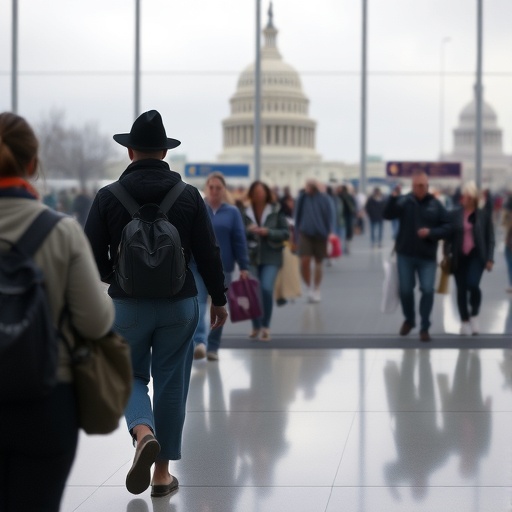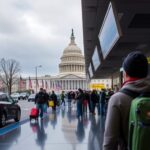Government Shutdown Crisis: 750,000 Federal workers Unpaid as Flight Delays and Public Service Disruptions Spread Nationwide
In a stark reminder of the human toll behind political gridlock, more than 750,000 Federal workers are entering their third week without paychecks as the ongoing government shutdown ripples through everyday American life. From harried travelers facing endless flight delays at major airports to families unable to access vital public services, the standoff in Washington is grinding the nation’s machinery to a halt. This isn’t just a budgetary dispute—it’s a crisis testing the resilience of workers, businesses, and communities across the country.
- Federal Workers Grapple with Mounting Financial Desperation
- Flight Delays Escalate as Air Traffic Controllers and TSA Agents Soldier On
- Public Services Buckle Under Shutdown’s Relentless Pressure
- Political Standoff Deepens: Lawmakers Trade Blame Over Shutdown Impasse
- Economic Repercussions Loom Large: Pathways to Shutdown Resolution Emerge
The shutdown, now the longest in U.S. history, stems from deep divisions over immigration reform and spending priorities. With no resolution in sight, Federal workers—many considered essential and required to work without compensation—are dipping into savings, relying on food banks, and even postponing medical care. “It’s heartbreaking to see dedicated public servants treated this way,” said Sen. Elizabeth Warren (D-MA) in a recent floor speech. “These aren’t faceless bureaucrats; they’re our neighbors, our teachers, our protectors.”
According to the Office of Personnel Management, approximately 800,000 federal employees were initially furloughed or working without pay, but the number of unpaid workers has stabilized around 750,000 as some agencies adapt. The economic fallout is estimated to cost the U.S. economy up to $1.5 billion per week, per a report from the Congressional Budget Office. As the impacts mount, questions swirl about how long Americans can endure this self-inflicted wound.
Federal Workers Grapple with Mounting Financial Desperation
For federal workers like Maria Gonzalez, a 45-year-old IRS auditor in Washington, D.C., the government shutdown has transformed routine worries into full-blown nightmares. Gonzalez, one of the countless federal workers now unpaid, hasn’t received her bimonthly paycheck since December 22. “My kids’ Christmas was bare-bones, and now we’re rationing groceries,” she shared in an interview with local news outlet WTOP. “I work 50 hours a week processing tax returns that fund this very government—how is this fair?”
Gonzalez’s story echoes thousands more. The Partnership for Public Service, a nonprofit advocacy group, reports that 85% of affected federal workers are either furloughed or working without pay, with many in essential roles at agencies like the Department of Homeland Security and the National Park Service. In a survey conducted by the group last week, 62% of respondents said they were using credit cards or personal loans to cover bills, while 28% feared foreclosure or eviction.
The financial strain isn’t limited to blue-collar employees. Dr. Alan Rivera, a veterinarian with the U.S. Department of Agriculture in California, oversees animal health inspections at ports of entry. Despite his critical role in preventing disease outbreaks, he’s unpaid and considering a second job. “I’ve got student loans from vet school hanging over me, and now this,” Rivera told The New York Times. “It’s demoralizing to serve your country and be left high and dry.”
Women and minority employees are hit hardest, according to a Government Accountability Office analysis. Female federal workers make up 43% of the workforce but report higher rates of childcare disruptions due to the shutdown. In urban centers like New York and Los Angeles, community food pantries have seen a 40% uptick in visits from government employees, per Feeding America data.
Back in the nation’s capital, protests are brewing. On January 10, hundreds of federal workers rallied outside the White House, chanting “Pay us now!” and holding signs reading “Shutdowns Hurt Families.” Union leaders like Everett Kelley of the American Federation of Government Employees warned of a “brain drain” if the impasse continues, with skilled professionals eyeing private sector jobs. “We’ve lost talent before during past shutdowns,” Kelley said. “This could be catastrophic for national security and public health.”
While back pay is promised once the shutdown ends, the immediate unpaid status has led to a spike in mental health issues. The National Alliance on Mental Illness notes a 25% increase in hotline calls from federal employees since the shutdown began, citing anxiety and depression linked to financial instability.
Flight Delays Escalate as Air Traffic Controllers and TSA Agents Soldier On
Airports from coast to coast are ground zero for the shutdown’s chaos, with flight delays surging as understaffed federal agencies scramble to keep skies safe. At Chicago’s O’Hare International Airport, one of the busiest in the world, passengers endured an average delay of 45 minutes last week—up 30% from pre-shutdown levels, according to FlightAware analytics.
The culprits? Air traffic controllers and Transportation Security Administration (TSA) officers, both groups of federal workers deemed essential and thus unpaid but required to report for duty. The Federal Aviation Administration (FAA) has furloughed 20% of its staff, leading to reduced maintenance on runway equipment and outdated flight planning software. “We’re running on fumes,” said an anonymous FAA technician in Atlanta’s Hartsfield-Jackson Airport. “Safety checks that used to take hours are now rushed because we’re short-handed.”
TSA screeners, numbering over 50,000 nationwide, face the brunt. At Los Angeles International (LAX), lines snaked for over an hour during peak holiday travel, prompting viral videos of frustrated families missing flights. TSA Administrator David Pekoske acknowledged the strain in a memo to employees: “Your dedication amid this government shutdown is unparalleled, but we must prioritize safety over speed.” Despite this, absenteeism has risen 15%, as unpaid agents call in sick to seek side gigs like Uber driving.
The ripple effects extend beyond delays. Airlines like Delta and American have issued waivers for rebooking, but small regional carriers are hemorrhaging cash—estimated at $100 million daily industry-wide, per the Air Transport Association. In Denver, a snowstorm exacerbated flight delays, stranding 2,000 passengers overnight and leading to brawls at gates.
International travelers are also affected. At New York’s JFK Airport, customs processing has slowed due to unpaid Customs and Border Protection officers, causing a backlog of 10,000 bags last weekend alone. Business leaders, including the U.S. Chamber of Commerce, have urged Congress to act: “Every delayed flight costs jobs and productivity,” said CEO Thomas Donohue.
Looking at data from the Bureau of Transportation Statistics, flight delays have increased by 22% nationwide since the government shutdown started, with the worst impacts in the Northeast corridor. Experts warn that prolonged disruptions could deter tourism, a sector already reeling from economic uncertainty.
Public Services Buckle Under Shutdown’s Relentless Pressure
Beyond the skies, public services are fraying at the edges as the government shutdown starves agencies of funds. National parks, once bustling with winter visitors, now operate on skeleton crews. Yosemite National Park in California has closed campgrounds and visitor centers, forcing rangers like Emily Chen to work unpaid shifts patrolling trails. “We’ve had to turn away school groups because we can’t afford basic supplies,” Chen recounted to NPR.
In urban areas, the strain is equally acute. The Environmental Protection Agency (EPA) has halted routine water quality inspections in 15 states, raising alarms about potential contamination risks. Meanwhile, the Small Business Administration (SBA) loan program is frozen, leaving entrepreneurs like Jamal Washington in Miami unable to secure disaster relief after recent floods. “I applied for a loan weeks ago, and now it’s in limbo,” Washington said. “This government shutdown is killing small businesses.”
Food safety is another casualty. USDA inspectors, many unpaid, have scaled back meat processing oversight, leading to temporary plant closures and price hikes at grocery stores. The Centers for Disease Control and Prevention (CDC) reports a dip in flu surveillance, just as cases spike seasonally.
At the state level, public services are stepping in where federal support lags. California’s Department of Social Services has expanded emergency aid for affected federal workers, distributing $5 million in grants. However, not all states can afford such measures; in rural Alabama, libraries funded by federal grants have shuttered, limiting access to job search resources.
Statistics paint a grim picture: The shutdown has idled 40% of federal housing programs, per HUD data, exacerbating homelessness in cities like Seattle. Veterans’ benefits processing has slowed by 50%, frustrating advocates. “Our heroes deserve better than bureaucratic neglect,” said VFW National Commander Vincent Troiola.
Nonprofits are overwhelmed. The Red Cross has mobilized to assist federal workers with utility bills, but demand outstrips supply. In a letter to Congress, the group pleaded: “End this government shutdown before public services become a distant memory.”
Political Standoff Deepens: Lawmakers Trade Blame Over Shutdown Impasse
In the marble halls of Capitol Hill, the government shutdown has devolved into a partisan blame game, with Democrats and Republicans pointing fingers over border wall funding and disaster relief packages. House Speaker Nancy Pelosi (D-CA) accused President Trump of holding the nation hostage: “This is not governance; it’s governance by tantrum.”
Trump, in a January 8 address, doubled down: “Democrats must fund the wall to secure our borders, or the shutdown continues.” Senate Majority Leader Mitch McConnell (R-KY) has blocked multiple compromise bills, citing the need for presidential approval. Bipartisan frustration is mounting; even Rep. Will Hurd (R-TX), a moderate, called for negotiations: “Federal workers and travelers shouldn’t suffer for our failures.”
Lobbyists from industries hit hardest—aviation, tourism, and manufacturing—are flooding Washington. The National Association of Manufacturers estimates $18 billion in lost productivity by month’s end if the shutdown persists. Public opinion polls from Gallup show 53% of Americans blame Republicans, a shift from earlier surveys.
Behind the scenes, talks brokered by Vice President Mike Pence have stalled over DACA protections. Immigration experts like Doris Meissner of the Migration Policy Institute argue the core issue is outdated policy: “This shutdown highlights the need for comprehensive reform, not temporary patches.”
Economic Repercussions Loom Large: Pathways to Shutdown Resolution Emerge
As the government shutdown stretches into uncharted territory, economists forecast a GDP hit of 0.2% in the first quarter, per Moody’s Analytics. Small businesses near federal installations report 25% revenue drops, while stock markets jitter with uncertainty— the Dow dipped 300 points on news of stalled talks.
Federal workers could see retroactive pay, but delayed tax refunds (projected at $200 billion) will squeeze consumer spending. Airlines warn of fare increases to offset flight delays, potentially adding $500 million to traveler costs annually.
Resolution paths are flickering. A Senate vote on a clean funding bill is slated for January 15, with moderates like Sens. Susan Collins (R-ME) and Joe Manchin (D-WV) pushing for compromise. If successful, agencies could reopen within days, restoring public services and easing burdens on unpaid staff.
Yet, if talks fail, experts predict extended fallout: heightened national debt risks, eroded trust in government, and a precedent for future shutdowns. As one federal worker in Virginia put it, “We’re all pawns in this game— but the board is cracking.” The coming week will test whether leaders can prioritize people over politics, averting deeper scars on the nation’s fabric.










